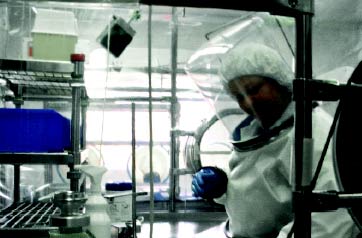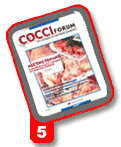Special Report
Advances in Cocci Vaccine Production
 Briggs and Lomurö
|
The way Martin Lomurö sees it,
protecting poultry against infection
from a wide range of
Eimeria organisms shouldn't be the
only objective of a coccidiosis vaccine.
"As a veterinarian, I concern myself
with other factors, like whether the
product is sterile and free of mycoplasma
and other viral, bacterial and fungal
contaminants that could introduce a
new disease to a flock," he says.
"I want to have a clear head about
its safety, consistency and efficacy. I
also want a product that's safe to
humans and friendly toward the environment."
Few veterinarians in the poultry
industry would argue with Lomurö's
high expectations for a vaccine. What's
unique about Lomurö is that he's not
the kind of vet who manages health
programs for one or even several poultry
companies.
As the manager of quality control at
Schering-Plough Animal Health
Corporation's coccidiosis vaccine plant
in the United Kingdom, Lomurö says
his concerns extend to hundreds of
progressive poultry operations in
Europe, the Middle East, Africa and
Latin America that have adopted this
approach to vaccination for coccidiosis
control with the company's Paracox™
vaccine line.
Meeting the growing demand
Lomurö smiles when asked about the
changes he's seen in coccidiosis vaccine
production since arriving at the UK
plant in 1995.
"Back then I had only one person
on staff and we shared facilities with
other departments," he says. "Today I
have 10 people reporting to me alone
and we have a whole QC lab to ourselves.
We've also become completely
self-reliant in that we hatch our own
chicks for potency testing, which gives
us the flexibility to retest or conduct
additional tests to assure quality.
"Since being acquired by Schering-
Plough Animal Health in 1997," he continues,
"we've seen a lot of expansion
and improvements. The company has
invested heavily in our facilities and
making sure our equipment and procedures
are state-of-the art."
Invested heavily, indeed.
Anticipating the growing demand
for coccidiosis vaccine throughout the
world, Schering-Plough Animal Health
Corporation spent more than €10 million
to increase the Paracox production
capacity and ensure the highest standards
for quality.
"Coccidiosis is all we do here,"
Lomurö says of the dedicated plant.
"For me and everyone else, coccidiosis
is our livelihood and we are all very
quality driven. There's no room for cutting
corners."
Demonstrating quality
But quality is not a feature that's readily
apparent with vaccines, concedes
Harold Briggs, the plant's quality assurance
manager who designs the regimented
systems and controls for
Lomurö's QC team to implement.
"If you buy a car, you can look at it,
drive it, and form your own opinion
about how good it is, and you know
right away if something isn't right,"
Briggs says. "It the same with food -
you can see or smell whether it's fit to
eat."
Rigorous QC Standards Guard Against Mycoplasma, Other Infectious PathogensAfter Paracox antigens have been sterilized, Quality Control produces a small batch of test vaccine to make sure it's free of viral contaminants. According to QC manager Martin Lomurö, this series of tests, which is repeated for every antigen, is different from the plant's sterility test and is subcontracted to the British government's central bacteria laboratory. "If there is a breakdown in the plant's antigens unit during production of a specific lot, we would take blood samples from the birds and do a whole range for serological tests to make sure their status had not been compromised during the period when the antigen was down," he explains. "Those tests alone run from £39,000 to £50,000 (€61,800 to €79,200), but we want producers and vets to be confident they're getting a coccidiosis vaccine that has been tested to the highest standard, free of other infectious agents and immunologically proven." |
Reputation takes over
It's a whole different story with vaccines,
however, where a certain degree
of blind faith needs to accompany
every dose. That, he says, is where a
manufacturer's name and reputation
take over.
"You use vaccine based on the
assumption that it was made to certain
specifications, it'll do what it's supposed
to do, and that it's not going to
harm you or your birds in any way.
"So the whole way that vaccines and
other animal health products are developed,
manufactured, tested, marketed
and distributed has to be designed with
that in mind," Briggs continues.
"Somehow, there needs to be an
absolute assurance that what the customer
purchases is what it's supposed
to be, without fail. Because with vaccines,
the consequences of failure tend
to be rather severe."
Having confidence in a product also
helps veterinarians and producers tackle
disease problems with more accuracy
and authority.
"When faced with a disease problem,
vets and producers can't be second
guessing a product's safety or efficacy,"
Briggs says. "So in order for them
to be sure, we have to put in place a lot
of checkpoints and think carefully
about their design and implementation
from beginning to end.
"That's really what quality assurance
is about. And that's why I say that quality
assurance is a philosophy, not a
department or a procedure."
As QA and QC managers, Briggs
and Lomurö are, in effect, internal auditors
"meticulous, detail-oriented people
who play by the book and accept
no compromises. It's their job to be
fussy and demanding.
"At the end of the day, I'm the guy
responsible for saying whether a product
meets the specifications and can be
released for sale," Briggs says. "And
before I make that decision, I will look
at all the conditions relating to the manufacture
and testing of the product. I
have to make sure that the product
was manufactured and tested according
to specifications and in compliance
with good manufacturing practices.
Schering- Plough Animal Health has its
own set of quality standards, which in
many cases are even higher than the
government's. If a batch doesn't meet
those criteria, it doesn't get shipped to
our customers."
Consistency is the key
Consistency from batch to batch is also
critical to the performance and safety of
a coccidiosis vaccine, explains plant
director Sue Bushnell, who supervises
70 scientists and technicians at the
company's primary and secondary production
facilities.
"Consistency needs to begin with
the vaccine's antigens," she insists.
"Every batch of vaccine that we produce,
because it's come from the master
strains, has exactly the same characteristic
as those very first experimental
isolates that were derived from the
field.
"From a product safety standpoint,
that is really, really important, because
organisms can change and mutate naturally,"
she continues. "But because
we're always going back and making
the vaccines from these master seeds,
we know that won't happen with
Paracox."
Producing coccidiosis vaccine
involves infecting mature, specific
pathogen-free (SPF) birds with one of
eight Eimeria organisms, which in turn
reproduce inside the birds and produce
oocysts, the eggs of the next generation.
The oocysts are then harvested
from the feces, sporulated, sterilized,
processed and blended in the right proportions
to produce the Paracox line of
vaccines. (See sidebar, page 12.)
While master seeds are critical for
the production of all live vaccines,
Bushnell says they are particularly
important to the success of Paracox
because the seeds are derived from
what researchers call "precocious"
strains of Eimeria "strains that were
deliberately selected for their shorter
reproductive life cycle and inability to
damage the gut wall.
"Precocious strains of Eimeria produce
oocysts earlier than conventional
strains, but in fewer numbers," she
explains.
This unique feature helps to slow
and reduce the level of oocyst infection.
As a result, the vaccine stimulates
the birds' natural immunity to Eimeria
without causing lesions and other
short-term damage to the gut of the
bird. This in turn means that birds vaccinated
with Paracox experience no
short-term setbacks in weight gain or
feed conversion from the deliberate
infection caused by the vaccine.
Keeper of the seeds
As manager of Schering-Plough Animal
Health's primary production facility for
Paracox, Richard Wood is the keeper of
the master seeds, which are carefully
preserved in a vat of liquid nitrogen.
The slightest change in temperature or
intrusion into the highly secure storage
area is enough to trigger alarms and
send technicians running.
"Anyone handling the master seeds
is allowed to handle one species a
day," the veterinarian says. "We also
have strict time limits for harvesting
oocysts from the master seeds. There's
only a 15-minute window, which is
much less than what we have on the
oocysts used when producing the actual
vaccine."
Wood notes that each Eimeria
species has a different level of reproductive
potential. Consequently, some
species can be reproduced with only a
handful of birds, while others might
require hundreds or even 1,000.
"Eimeria necatrix, which goes into
our breeder vaccine, is one of the
species which is not very immunogenic,"
Wood explains. "So we need to
produce a lot of it to produce the vaccine.
Not only do we harvest the material
over a 72-hour period, but we have
to use over 1,000 birds each time -
and that's just to produce 10 million
doses or less."
Eimeria tenella, used in both the
breeder and boiler vaccines, also presents
special production challenges
because technicians need to harvest
both fecal matter and the guts of the
infected birds.
"We've got a high level of control in
all our processes," Wood concludes.
"The fact that we start off with very
dirty material "chicken feces "and
produce a sterile, highly efficacious
and safe product that's free of
mycoplasma and other pathogens is
really quite an accomplishment. It takes
a lot of experience to make a high
quality coccidiosis vaccine."
'Most fantastic achievement'
 Technician encased in a half-suit
isolator used to protect the smallbatch
test product.
|
Martin Shirley, the coccidiologist at the
UK's Institute of Animal Health who
helped isolate and develop the precocious
lines of Eimeria used in Paracox,
says he feels like a proud father anytime
he visits Schering-Plough Animal
Health's production facility.
"Back in the 1970s, when we were
looking at the future and the idea of
replacing traditional anti-coccidials
with a vaccine, we always hoped it
would become big," he says. "But quite
honestly, I don't think we really realized
that the market would become so
huge.
"When I visit the Schering-Plough
Animal Health plant, I'm always overwhelmed
by the expansion, the stateof-
the-art procedures and what it's
actually producing.
"Coming up with the master seeds
was one thing, but I think what
Schering-Plough Animal Health has
done to develop the product is the
most fantastic achievement," Shirley
says.







